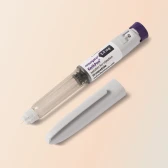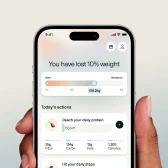Testosterone is often linked to strength, energy and muscle growth, but it also affects how your body stores fat, builds muscle and burns calories. In other words, it can influence your body shape and weight.
Here’s what science says about how testosterone and weight are connected—and what you can do to keep your levels in a healthy range.
Testosterone and weight: A two-way street
Testosterone and body fat influence each other in a two-way relationship.
High body fat can lower testosterone: Fat tissue, especially around the belly, contains an enzyme called aromatase that turns testosterone into estrogen. More estrogen can signal your body to produce less testosterone.
Less testosterone levels can also reduce muscle mass, which slows your metabolism, making it easier to gain fat. Low testosterone also encourages your body to store fat and slows down fat breakdown, further contributing to weight gain.
So, low testosterone and excess fat can create a cycle that’s hard to break.
4 ways testosterone affects weight and body shape
Testosterone influences various components of metabolic regulation, each of which plays a role in weight management and body composition. Here’s more detail on why testosterone can impact your shape and weight:
1. Muscle mass and energy expenditure
Testosterone helps build and maintain muscle. Muscle burns more calories than fat, even when you’re at rest. This means more muscle helps you use energy efficiently and burn fat.
2. Fat distribution
Healthy testosterone levels are linked to healthier fat distribution. Men with low testosterone often carry more fat around the belly, which is associated with insulin resistance, inflammation, and higher risk of heart disease.
3. Insulin sensitivity
Testosterone affects how your body uses sugar. Low levels can make your body less sensitive to insulin, leading to higher blood sugar and more fat storage. Some studies show that testosterone therapy can improve insulin sensitivity.
4. Energy regulation and activity
Testosterone can influence your energy levels and drive to be active. Feeling more energetic can make it easier to exercise, which is important for weight management.
Does testosterone replacement therapy (TRT) help with weight loss?
For men with clinically low testosterone, testosterone replacement therapy (TRT) can help restore hormonal balance and improve body composition. TRT can increase lean mass, reduce body fat and improve metabolic markers like insulin sensitivity and lipid profiles.
While TRT isn’t a “weight-loss treatment,” it can make it easier to maintain a healthier body composition—especially when combined with regular exercise and a balanced diet.
Lifestyle changes that boost testosterone
Speaking of exercise and diet, lifestyle habits can also help keep your testosterone levels in a healthy range—and support your weight goals:
Lose excess weight
Losing even a little body fat can help your body make more testosterone naturally.
Exercise regularly
Strength training and high-intensity interval training (HIIT) can boost testosterone and build muscle.
Prioritise sleep
Deep, quality sleep is essential for hormone production.
Eat for hormone health
Eating enough zinc, magnesium, vitamin D, and limiting processed foods, supports testosterone. Read more about testosterone-boosting foods.
Manage stress
Chronic stress increases cortisol, which can lower testosterone.
Curious about your T levels?
Balanced testosterone levels can support a healthy weight, energy, and mood. If you’re noticing weight gain, fatigue, or a drop in libido, it might be worth checking your testosterone.
An at-home testosterone blood test can give you answers—and help your doctor decide whether testosterone replacement therapy could be the right fit for you.












